© www.1600i.de
created by Phil Ade 31.12.2007
1600i Fuel System Diagnosis
Precheck List:-
The following tools are required to test the fuel pumpís delivery:-
Preferred Tool |
Suitable Alternative Tool |
|
Glass
measuring jug in ml |
|
|
Remote
control VAG 1348/3A with the VAG 1348/3-2 adapter cable. |
ECU connector
box. |
|
Fuel
injection pressure test kit, eg:- -
VAG 1318 and
VAG 1318/10, VAG1318/11, VAG 1318/1 hoses -
Sealey VSE
210 -
Sealey VSE
211 (with a modified car pump tyre connector drilled out to 9.5mm or 3/8Ē). |
Modified car
tyre pump where the following bits are used:- -
Tyre
connector (drilled out to 9.5mm or 3/8Ē) -
Pressure
gauge -
Clothes peg
or hose clamp -
Fuel hose
(after the pressure gauge). |
Manfred had
suggested to me about using a modified tyre valve connector to fuel injection
(VW Digijet) test port and it works a treat.
Caution:† When drilling out the tyre valve connector,
make sure that the following are observed:-
-
Tyre valve
connector level unlatched
-
Donít drill
into the tyre valve connector too far down !!!
Hereís what
Manfredís modified tyre pump valve connector looks like.†† The drilled out one is on the left hand
side of the photo below:-

Testing the fuel
pump delivery:-
First of all
connect a suitable fuel pressure test kit to the fuel injection test port of
the 1600i engine bay.† This is shown in
the following photo below:-
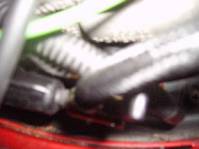
Hereís what
the entire setup looks like on my car:-
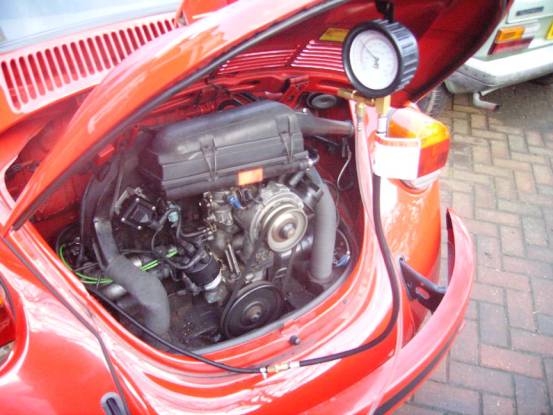
Note:† When testing the fuel pump
delivery, make sure that the safety valve on the pressure gauge is open !!!
The previous photo is of my Sealey VSE211 fuel injection test set with the
modified tyre valve hose installed.†
However if you donít have a fuel injection pressure test set, there is a
much cheaper method of making your own test set (Manfred came up with the
idea).† Hereís what Manfredís home made
fuel injection pressure test set looks like:-

The clothes peg is used as a safety valve for measuring fuel pressure and is released to measure the fuel pumpís delivery rate.† The pressure gauge its self (and the hoses) all came from a car tyre pump and the whole lot only cost him 5.60 Euros (instead of £70 + £3.99 for my Sealey VSE211 + car pump).
This is what Manfredís fuel pressure test set looks like when itís installed on one of his (original) 1600i beetle (the green syringe was used to test the fuel pressure regulator).
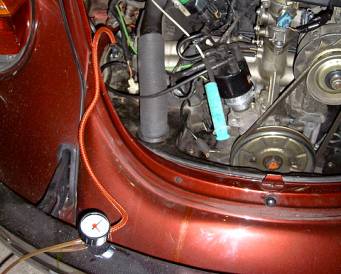
There are two methods of testing the fuel pumpís delivery which will be covered below:-
Using the VAG 1348/3A Remote Control (or equivalent):-
To test the fuel pump, remove relay 80 (fuel pump relay) from itís socket.† See my photo on the 1600i website for further details (under Electronics, 1600i Engine Bay).
Itís also possible to make up a simple lead with a push button switch box to do exactly the same job.† All you will need is the following:-
- Male spade connector (for the fuel pump relay socket)
- Female spade connector (to connect to the positive live part of the fuse box)
- Push to make push button switch.
- A high current 12V relay.† This must have a rating of at least 10 Amps !!† These are available from Maplin for about £5.
- Approximately 5 metres of cable (any old mains flex will do).
- A small piece of stripboard (if the relay is a PCB one).
- A small ABS plastic box
Hereís what
the circuit would look like:-
Battery
plus
††††††††††††††††††††††††††††††††††††††††††††††† †

††††††††††††††††††††††††††††††††††††††††††††††† †
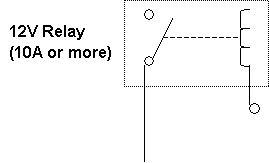
![]() ††††††††††††††††††††††††††††††††††††††††††††††††††††††††††††††††††††††† ††††† Push
to make
††††††††††††††††††††††††††††††††††††††††††††††††††††††††††††††††††††††† ††††† Push
to make
Relay 80,
pin 4![]()
![]()
††††††††††††††††††††††††††††††††††††††††††††††††††††††††††††††††††††††† ††††† Pushbutton
switch
![]()
Now connect
the VAG 1348/3A (or equivalent) remote control and the VAG 1348/3-2 adapter
cable from battery positive to pin 4 of the fuel pump relayís socket.† Do
not switch on the ignition !!!
Operate remote
control for exactly 10 seconds.
Using an ECU connector box (Manfredís method):-
This method is
different to the one above.† To test the
fuel pump in this case, do the following:-
-
Disconnect the
battery earth
-
Remove the 25
pin plug from the ECU
-
Connect the ECU
test boxís lead to the ECU lead
-
Reconnect the
battery earth
-
Switch on
ignition
-
Short out pins
6 and 13 on the ECU test box to make the fuel pump run for exactly 10 seconds.
Hereís what Manfredís ECU
test box looks like:-

The amount of
fuel delivered in both cases must be
350ml.† If thatís not the case then
the following will need to be checked.
-
Fuel pump
relay (relay 80) Ė Operation and condition of solder joints.† Replace it if necessary.
-
Fuel
filter.† Replace if necessary.
-
Fuel hoses Ė
check for leaks and damage.† Also check
the fuel lines for blockages.
-
Fuel
pump.† Replace if necessary.
Fuel Pressure Test:-
To check the
fuel pressure of the fuel injection system, do the following:-
-
If a remote
control box was connected, disconnect it and re-install the fuel pump relay
back into itís socket.
-
If an ECU test
box was used, disconnect it and reconnect the ECUís plug back into the ECU its
self.
Now close the
fuel pressure release valve lever (or put the clothes peg back onto the drain
hose of the home made fuel pressure test kit) and start the engine.
Initially the
fuel pressure when the engine is cold will be at about 3.0 bar and should drop
to about 2.5 bar as the engine warms up.
Here is what
the fuel pressure looks like on my car when the engine has warmed up:-
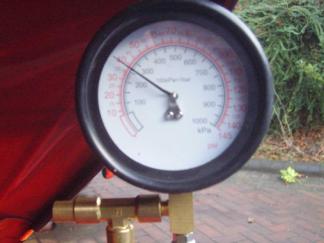
Now disconnect
the vacuum hose to the fuel pressure regulator from the inlet manifold end.††
The pressure should now rise to 3.0 bar:-
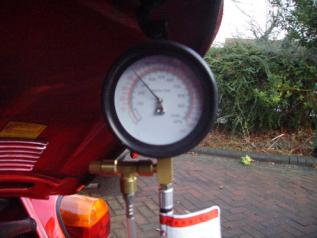
Now switch off
the engine.† The fuel pressure should
now slowly drop and should be at least 2.0 bar 10 minutes later:-
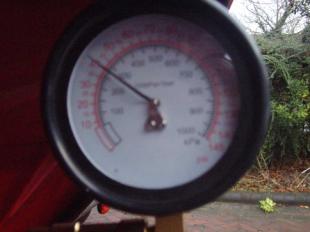
Now reconnect
the vacuum hose back onto the inlet manifold.
If the fuel
pressure doesnít drop at all or the fuel pressure drops below 2.0 bar then the
fuel pressure regulator must be replaced.
Note:
On the Sealey fuel injection pressure test sets 100 kPa = 1 bar.